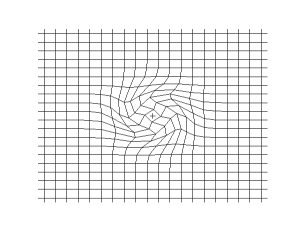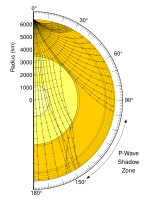S wave: Difference between revisions
Mikenorton (talk | contribs) m Reverted edits by 90.200.182.198 (talk) to last version by Mikenorton |
|||
| Line 50: | Line 50: | ||
:<math>\beta^2=\frac{\mu}{\rho}.\ </math> |
:<math>\beta^2=\frac{\mu}{\rho}.\ </math> |
||
This describes S-wave propagation. Taking the [[divergence]] of seismic wave equation in homogeneous media instead of the curl, yields an equation describing P-wave propgation. |
This describes S-wave propagation. Taking the [[divergence]] of seismic wave equation in homogeneous media, instead of the curl, yields an equation describing P-wave propgation. |
||
==See also== |
==See also== |
||
Revision as of 20:25, 24 May 2012
This article may be in need of reorganization to comply with Wikipedia's layout guidelines. (January 2009) |
This article includes a list of references, related reading, or external links, but its sources remain unclear because it lacks inline citations. (January 2009) |


A type of elastic wave, the S-wave, secondary wave, or shear wave (sometimes called an elastic S-wave) is one of the two main types of elastic body waves, so named because they move through the body of an object, unlike surface waves.
The S-wave moves as a shear or transverse wave, so motion is perpendicular to the direction of wave propagation: S-waves are like waves in a rope, as opposed to waves moving through a slinky, the P-wave. The wave moves through elastic media, and the main restoring force comes from shear effects. These waves do not diverge, and they obey the continuity equation for incompressible media:

Its name, S for secondary, comes from the fact that it is the second direct arrival on an earthquake seismogram, after the compressional primary wave, or P-wave, because S-waves travel slower in rock. Unlike the P-wave, the S-wave cannot travel through the molten outer core of the Earth, and this causes a shadow zone for S-waves opposite to where they originate. They can still appear in the solid inner core: when a P-wave strikes the boundary of molten and solid cores, called the Lehmann discontinuity, S-waves will then propagate in the solid medium. And when the S-waves hit the boundary again they will in turn create P-waves. This property allows seismologists to determine the nature of the inner core.[1]
As transverse waves, S-waves exhibit properties, such as polarization and birefringence, much like other transverse waves. S-waves polarized in the horizontal plane are classified as SH-waves. If polarized in the vertical plane, they are classified as SV-waves. When an S- or P-wave strikes an interface at an angle other than 90 degrees, a phenomenon known as mode conversion occurs. As described above, if the interface is between a solid and liquid, S becomes P or vice versa. However, even if the interface is between two solid media, mode conversion results. If a P-wave strikes an interface, four propagation modes may result: reflected and transmitted P and reflected and transmitted SV. Similarly, if an SV-wave strikes an interface, the same four modes occur in different proportions. The exact amplitudes of all these waves are described by the Zoeppritz equations, which in turn are solutions to the wave equation. S-waves are slower than P-waves.
Theory
The prediction of S-waves came out of theory in the 1800s. Starting with the stress-strain relationship for an isotropic solid:
where is the stress, and are the Lamé parameters (with as the shear modulus), is the Kronecker delta, and the strain tensor is defined
for strain displacement u. Plugging the latter into the former yields:
Newton's 2nd law in this situation gives the homogeneous equation of motion for seismic wave propagation:
where is the mass density. Plugging in the above stress tensor gives:
Applying vector identities and making certain approximations gives the seismic wave equation in homogeneous media:
where Newton's notation has been used for the time derivative. Taking the curl of this equation and applying vector identities eventually gives:
which is simply the wave equation applied to the curl of u with a velocity satisfying
This describes S-wave propagation. Taking the divergence of seismic wave equation in homogeneous media, instead of the curl, yields an equation describing P-wave propgation.
See also
- P-Wave
- Love wave
- Rayleigh wave
- Lamb waves
- Longitudinal wave
- Surface wave
- Shear wave splitting
- Earthquake Early Warning (Japan)
References
- ^ University of Illinois at Chicago (17 July 1997). "Lecture 16 Seismographs and the earth's interior". Retrieved 8 June 2010.
Further reading
- Shearer, Peter (1999). Introduction to Seismology (1st ed. ed.). Cambridge University Press. ISBN 0-521-66023-8.
{{cite book}}:|edition=has extra text (help)
- Aki, Keiti (2002). Quantitative seismology (2nd ed. ed.). University Science Books. ISBN 0-935702-96-2.
{{cite book}}:|edition=has extra text (help); Unknown parameter|coauthors=ignored (|author=suggested) (help)
- Fowler, C. M. R. (1990). The solid earth. Cambridge, UK: Cambridge University Press. ISBN 0-521-38590-3.















